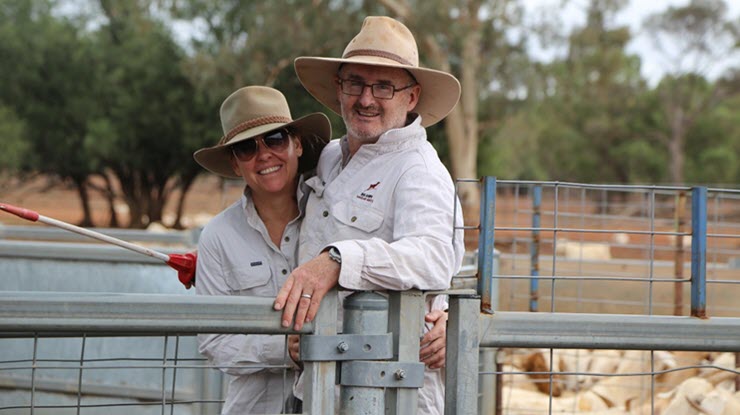Nutritional management key to goat reproductive success
15 March 2021
 James Boland, with wife Belinda at the Big Ampi Rangeland Goats yards, says doe nutrition is vital to the success of out-of-season joining.
James Boland, with wife Belinda at the Big Ampi Rangeland Goats yards, says doe nutrition is vital to the success of out-of-season joining.
Key points:
- Collaborative research project aimed to understand the baseline reproductive wastage for the goat industry to improve producer awareness and management of kid loss.
- The study showed increasing doe weight at mating can improve fertility, pregnancy rate and litter size.
- Data from the study has validated that overall, out-of-season joining was profitable for Big Ampi Rangeland Goats.
A careful focus on nutritional management has allowed Big Ampi Rangeland Goats co-owner James Boland to boost the reproductive efficiency and profitability of their enterprise.
James says during dry periods, many people approach nutrition as something they cannot afford to do however, he believes correct nutrition is foundational to best practice goat management and it is prioritised at Big Ampi.
Big Ampi Rangeland Goats is a large-scale managed goatmeat enterprise based in the semi-arid New South Wales western division.
The business began by growing out wild-caught feral goats and moved to farmed boer cross goats in 2017.
“We started growing out undersize feral goats and joining bucks to feral does, and moved into a more managed scenario using a recognised meat breed in 2017,” James said.
“We invested in genetics and nutrition, and began crossing boer bucks across a mob of boer-cashmere does.
“While we still run some feral goats, our main enterprise is now managed bred goats to provide the domestic and export market with a reliable year-round supply of goats which reach a 35kg live weight in six months.”
Understanding baseline reproductive wastage
Big Ampi became involved in a collaborative research project undertaken by Meat & Livestock Australia (MLA) and NSW Department of Primary Industries in 2019, as they were interested in applying the latest science and research to their enterprise to improve efficiency.
The project aims to:
- understand the baseline reproductive wastage for the goat industry, including neonatal losses and weaning rates
- improve producer awareness and management of kid loss.
James said data from the project supported the business’s decision to complete out-of-season joining.
“Research has demonstrated out-of-season joining can be detrimental to reproductive efficiency as goats are seasonal breeders,” James said.
“We complete out-of-season joining as it enables us to run three joinings every two years, and this works better from a management perspective.
“While reduced reproduction is reflected in lower scanning and marking percentages, the data from the study validated that overall, out-of-season joining is profitable in our enterprise.”
Nutrition is a huge contributor to the reproductive success at Big Ampi and the research has shown managing nutrition can help to reduce reproductive loss.
“We have learnt a few lessons on the price you pay if you don’t look after and manage the nutritional requirements of your does,” he said.
“We try to ensure there is enough native herbages, browse and summer and winter pasture species to provide diversity and feed for the goats year-round.”
Nutrition is key
Big Ampi also ensures the goats have access to supplementary feed if there is not enough cover for efficient grazing.
Nutritional requirements of the does are managed depending on whether they are joining, gestating or lactating.
“When we are joining our does, we ensure they are on a rising nutritional plane to make sure they have good body condition,” James said.
“We begin to move the does into poorer paddocks or cut supplementary feeding back during early gestation as we need to ensure they do not become over-conditioned.
“The paddocks with good feed cover and the high protein supplementary feed such as vetch, lucerne hay or faba beans are saved for late gestation, kidding and lactation.
“Pregnant does are moved into those paddocks six weeks out from kidding.”
Improving fertility
Data from the project also showed increasing doe weight at mating can improve fertility, pregnancy rate and litter size, a practice which Big Ampi already implements in the business.
“All of our maiden does are classed based on weight at 15 months of age,” James said.
“Any maiden does which are lighter than 45kg are removed from the breeding herd and we hold them for a couple of months until they reach the desired breeding weight.
“We run a 6% buck ratio when joining maiden does and we ensure joining is completed in small paddocks which have a good standard of feed.”
Paddock cover and water access are important factors James assesses when does are kidding.
“Wild pigs, wild dogs and wedge-tailed eagles are common predators in our district, which can cause significant kid losses,” James said.
“We try to ensure we kid in paddocks with good timber cover so the does and their newborns can utilise the cover for protection from the elements and predators.
Next year, Big Ampi will focus on collecting data on maiden does and their reproductive efficiency.
“COVID-19 restrictions in 2020 meant there was reduced opportunity to collect maiden doe reproductive data during the project.
“We are also interested in utilising melatonin implants to help us improve our out-of-season joining and looking into opportunities to develop pheromone triggers which may help bring does into oestrus.”


